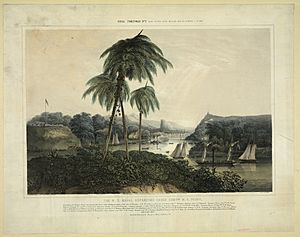USS Spitfire (1846) facts for kids
Quick facts for kids History |
|
|---|---|
| Name | USS Spitfire |
| Acquired | by purchase, 14 July 1846 |
| Commissioned | 21 August 1846 |
| Fate | Sold, 1848 |
| General characteristics | |
| Type | Gunboat |
| Displacement | 241 long tons (245 t) |
| Length | 119 ft (36 m) |
| Beam | 22 ft 6 in (6.86 m) |
| Depth | 9 ft 3 in (2.82 m) |
| Propulsion | Steam engine |
Imagine a fast, steam-powered boat used for fighting on rivers and near coasts – that was the USS Spitfire! This special ship was a gunboat with big paddle wheels on its sides. It played an important role for the United States Navy during the Mexican–American War.
Just six days after President James K. Polk declared war on Mexico in May 1846, the US Navy decided to buy Spitfire. This ship, along with another called Vixen, was actually being built for the Mexican Navy! The US Navy got the Spitfire on July 14, 1846. It officially joined the Navy on August 21, 1846, with Commander Josiah Tattnall III in charge.
Spitfire's Adventures at Sea
After delivering important messages for US forces in California, the Spitfire joined the American ships blocking the port of Vera Cruz on November 10. Because it was a new and strong ship, designed for Mexico's Gulf Coast, it made Commodore David Conner's fleet much stronger.
Taking Over Tampico
On November 12, the Spitfire set off with the fleet to attack Tampico. The American ships gathered outside Tampico on the morning of November 14. At 10:45 AM, Commodore Conner himself boarded the Spitfire and used it as his main ship during the attack. They started firing around 11:00 AM.
The Spitfire and other light ships, along with boats from bigger warships, moved across the sandbar and up the Pánuco River. They passed the fort guarding the river. In the early afternoon, people from Tampico came aboard the Spitfire to talk about surrendering. No official agreement was made. However, after US soldiers landed and took over the town, Commodore Conner decided a formal surrender wasn't needed.
Two days later, boats from Spitfire and Vixen went further up the Panuco River. They captured three small Mexican gunboats. On November 18, Spitfire and the schooner Petrel traveled even further up the river. They captured the town of Pánuco the next morning. They also destroyed nine Mexican cannons and a large amount of cannonballs. After burning military supplies, they headed back downstream on November 21.
On November 25, a strong storm, called a "norther," sank another ship named Neptune at Tampico. The Spitfire quickly rescued all of Neptune's crew, saving everyone. On December 13, Commodore Conner left Tampico. He put Commander Tattnall in charge until enough Army troops arrived to hold the town. Because of this, Spitfire did not return to Vera Cruz until January 3, 1847.
The Battle for Veracruz
Soon, plans were made to attack the important port city of Vera Cruz. On March 9, the Spitfire led a group of gunboats and other light ships close to the shore. They helped the Army troops land and surround the city.
Just after sunrise the next day, the Spitfire anchored east of the fortress at San Juan de Ulúa. It started firing at the castle to distract the Mexicans. This allowed General Winfield Scott to move his headquarters ashore that morning. After about 30 minutes of fighting, the Spitfire moved back out of range of the Mexican cannons.
The next few days were spent getting ready for a long attack on the city. In the afternoon of March 22, when the main firing began, the Spitfire led Commander Tattnall's group of gunboats. They attacked the city walls near the shore and kept firing until dark. The Spitfire's shots were praised for being very accurate and effective. During this battle, the cannons in the fortress fired at the gunboats, but none of the ships were damaged.
That night, Spitfire's second-in-command, Lieutenant David Dixon Porter, bravely took a boat into Vera Cruz harbor. He wanted to find the best spot for the gunboats to fire from when they started shelling again.
The next morning, Tattnall sailed his gunboats very close to Fort Santiago. They were so close they were within "grape-shot" range, meaning the fort's small, scattered cannonballs could reach them. The gunboats fired at both the town and the fort. The Mexican cannons fired back, but they couldn't aim low enough to hit the brave American gunboats.
More Operations
After Vera Cruz surrendered, the Spitfire joined expeditions to Alvarado and Tuxpan. It even served as Commodore Matthew C. Perry's main ship during the capture of Tuxpan.
On June 14, the Spitfire was part of the force that took Frontera, a town at the mouth of the Tabasco River. The American ships then went up the river. They fought Mexican cannons at three different places on the Tabasco River. On June 16, they occupied the city of Tabasco. The American warships stayed there until July 22, when they headed back down the river towards the Gulf of Mexico.
By this time, most of the fighting for the Navy in the Gulf of Mexico had ended. After doing routine jobs like protecting Army supply lines and communications, the Spitfire returned home. It was sold in Norfolk in 1848.


